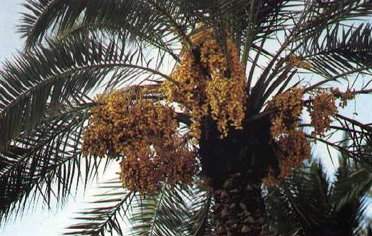
|
|
Date palm (Phoenix
dactylifera L.)
|
Date palm (Phoenix
dactylifera L.)
Date palm,
Phoenix dactylifera L., is one of the oldest fruit trees in the world and is mentioned in the Qur'an and
Bible.
The number of the date palms is about 100 million worldwide, of which 62
million palms can be found in the Arab world. The place of origin of the
date palm is uncertain. Some claim that the date palm first originated in
Babel, Iraq, as the earliest evidence of date Palm cultivation was during
the Eridu period (5.000 B.C.) in Lower Mesopotamia.while others believe that it originated in Dareen or
Hofuf,
Saudi Arabia or Harqan, an island on the Arabian Gulf in Bahrain.
The date palm, is also native to North
Africa.
It has been extensively cultivated in all arabian areas, where it features as the
characteristic vegetation of oases. Moreover it is grown over the Canary
Islands, in the northern Mediterranean and in the south of the United
States.
This palm, well known since ancient
times, was regarded
by the Egyptians as being a fertility symbol, it was represented on coins
and monuments by the Carthaginians and used as an ornament in triumph
pageants by the Greeks and Romans. In the Christian tradition, its leaves
have symbolised peace and reminded of Jesus' entry to Jerusalem.
Its generic name is an ancient
name,
already quoted by Theophrastus, as the one by which the Greeks used to
call plants belonging to this genus; it derives from phoenix =
Phoenician, as the Phoenicians themselves were supposed to have spread
these plants. Its specific name is composed by dactylus = date (from
Greek dactylos) and fero = I bear, that is, date-bearing.
The date
palm is a perennial. It is an imposing palm with a very
slender trunk, up to 30 m tall, conspicuously covered with the remains of
sheaths from fallen leaves. Its leaves, clustered together in a maximum
number of 20-30 and forming a loose crownshaft, are pinnate, up to 6 m
long, upper leaves are ascending, basal leaves are recurved, the segments
are coriaceous, linear, rigid and sharp pointed, blue-green in colour. Its
flowers, unisexual on dioecious plants, are small, whitish, fragrant, clustered in axillary spadices up to 120 cm long
markedly bent downwards by their fruit weight. These fruits, commonly
known as dates, are oblong berries, dark-orange when ripe, up to 50 cm
long in the cultivated varieties, their flesh is sacchariferous, it
contains one woody seed. The female
palnts normally begin to bear dates
within an average five of years from the time of planting of the offshoot.
The date palm reaches an age of about 150 years.
It is a plant sensitive to the cold, it thrives on any kinds of
soil, provided that they are fertile and well drained; in mild climate
regions, it is grown outdoors where it must be
exposed to the sun; it is grown chiefly as an ornamental plant on account
of its slender habit and foliage. In order for its fruits to come to a
complete maturity, rather high temperatures (40įC) and copious water
amounts, these being sometimes provided by means of irrigation in
production palms, are required.
It propagates by suckers or seeding in spring.
The
fruit of the date palm is delicious and sweet. Dates, due to their high sugar
content, represent the basic, fundamental food for North Africa, Arabia
and Persia's peoples, where hundreds of varieties are grown for commercial
purposes. On
a commercial scale, the Middle East and North Africa are the major date
palm producing areas in the world.
Source:
http://www.redpalmweevil.com/introDatepalm.htm
http://www.dipbot.unict.it/Palms/descr02.html
http://www.levity.com/alchemy/islam08.html
